

SINGLE SKIN SINGLE LINE KITES UPDATE
Peter Lynn, April 2023
Kite Origins
The first kites were most likely leaves, that, quite by chance, fly as kites when a line is attached to them in the right place. Their discovery could easily have happened when such leaves were used to float fishing lines out to where the fish were- most likely in Indonesia (where Lokoloko leaves are still used for kite fishing), and possibly more than 10,000 years ago.
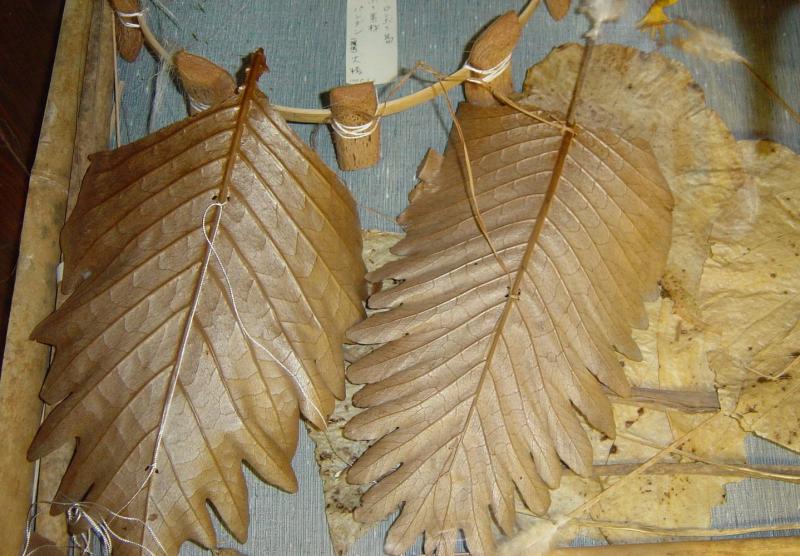
Leaf kites are a type of framed kite: Their structure is the spine and ribs, the 'covering' being the leaf membrane.
From this beginning, framed kites then developed to use wood or bamboo structures (now carbon fibre) with a covering material - now commonly paper or fabric. Framed kites are made in a huge range of shapes and sizes, with the traditional 'two sticks and a tail' 'kite' shape still being what most people immediately picture when they hear the word kite.
In the 1950's, another genre- the ram air inflated kite- was developed by Canadian born, Florida domiciled Domina Jalbert. Ram air kites have no sticks or rigid structures. They use air pressurised by the 'stagnation pressure' of wind flow to inflate internal spaces and resist compressive forces. Ram air style single line kites include 'parafoils' used as lifting kites, through to the huge range of 'themed' designs that now populate international kite festivals. Ram air inflated kites can also be made in very large sizes.
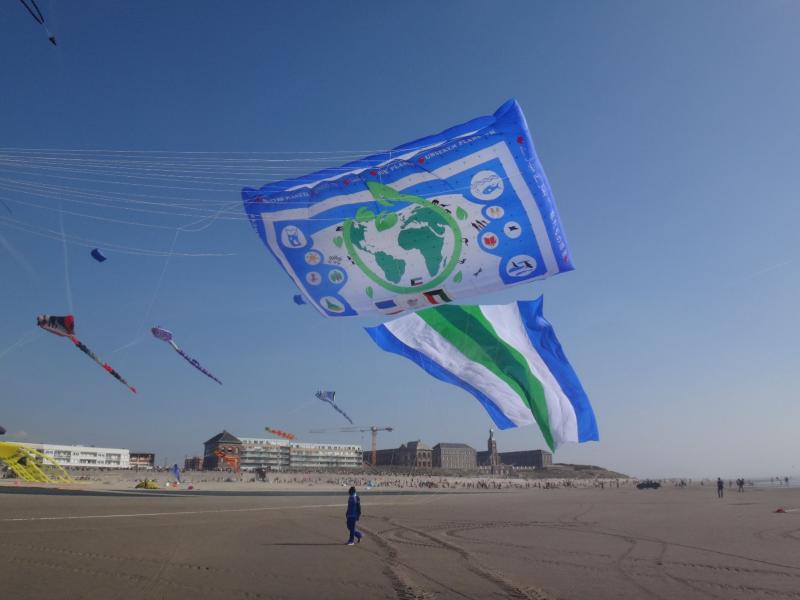

There are also rigid kites- built of balsa wood like model aeroplanes, or more often now from foam and carbon fibre. In the 1970's I did a lot of experimentation with kites made of expanded polystyrene- they were a great way to quickly try out different shapes- and to figure out why kites (mainly don't) fly.
There is a fourth genre of single line kites, those that have a single soft skin, no sticks or other structural members and no internal spaces. Examples of such kites have been known since before Jalbert: Parasails (towed parachutes) are of single skin construction and fly on a single line in the same way as a kite. But parasails depend on having a person weighing 30 or more times the weight of the canopy hanging below to keep them pointed upwards, which is not practical for most kite applications.
In 2013, looking for a new challenge (that is, bored), and with a big heap of left-over fabric in unsaleable colours to get through before carking, I set out to see whether single skin single line (SSSL) kites could be developed that would fly satisfactorily. In this I'm indulging a desire to get back to kites that fly alone on a single line in the classical sense. Kite events now routinely feature a huge range of fantastical ram air inflated creatures. Some of these will fly by themselves but most are lifted under, or at least stabilised by parafoil type 'pilot' kites. These stacks of show kites have bought new life to the kite flying world- and require considerable understanding of aerodynamics and kite making skill. But there's something special about 'back to the origins' kites that fly by themselves away up there, and I've always been a sucker for ideas that are new and unexplored.
From the start of this new project, I added two additional criteria to the single skin single line principle: No added weights and no stiffeners of any kind, not even stiff fabric. Although realising that weights and stiffeners could improve reliability in gusty conditions, I felt they would interfere with my learning how to understand and control the tiny pressure differences that are all that is otherwise available to resist compressive and buckling loads- if it can be established in fact that they can be adequate for this purpose. Avoiding dependence on fabric stiffness also allows designs to be scalable.
Now 10 years (and 1000's of hours) into this I can confidently state that it is possible to make fully functional single skin kites without using stiffening of any kind.
The following is what I have learnt so far: A lot of failures, a few usable designs, and some theories, basic techniques and systems that can be built on should anyone else ever become similarly afflicted with the challenge of single skin single line kites.
For an account of my current understanding of kite stability (still puzzled!), see "Single Line Kite Stability, Peter Lynn 2023
Definitions
Aspect ratio: Width relative to length, technically; span squared divided by area.
Angle of attack: angle that the wind strikes a kite's lifting surfaces at.
Apparent wind: Air velocity that a kite experiences (can be more or less than the true wind).
Centre of gravity: Where the sum of a kite's weight forces (including bridles and line) act.
Centre of lift: Where lift forces act- found by sighting up the kite's line.
Chord: a kite's length (excluding tail).
Diving over: High speed dive to the ground, or nearly to, at one side.
Drag: Aerodynamic drag forces that pull a kite in the wind direction
Falling off; collapsing to left or right after stalling.
Lateral area: Keels, flares, fins and other vertical (as opposed to horizontal) area.
Lateral correction. When a kite returns to centre from being laterally displaced.
Leading edge: A kite's front edge
Lean: when a kite is not pointing straight up
Leaning correction: returning to vertical from a lean.
Leaning over: Slowly leaning off to one side or the other- sometimes to the edge of the wind window
Lift: Aerodynamic lift forces that enable kites to fly
Lift to drag ratio: Aerodynamic efficiency; tangent of the flying line angle.
Luffing: When a kite's leading-edge dips under the wind, causing the kite's line to lose tension.
Righting moment: a kite's weight x's the distance between its centre of lift and centre of gravity.
Span: a kite's width
Stalling: When a kite falls back, will not climb, or won't launch- when lift is less than weight.
SSSL: Single skin, single line kite.
True wind: Actual wind speed at the kite.
Trailing edge. A kite's rear edge.
Weaving: Repeating lateral movements that sometimes builds to looping as wind speed increases.
First Law (of kites)
Single line kites can only fly if their centre of gravity (where the weight forces act) is behind and generally below their centre of lift (where the lift forces act). The weight force pulling downwards against the lift force pulling up, points the kite upwards. If the centre of lift is behind the centre of gravity, the kite will turn around and try to fly backwards instead. This is a necessary condition in the absence of which a kite can't fly. It is not a sufficient condition however, because it doesn't by itself ensure stable flying.
Single Line Kite Instability
The main types of instability are:
Leaning over: Slowly leaning off to one side or the other- sometimes to the edge of the wind window..
Diving Over: Rapid diving to the ground, or nearly to, at one side or the other.
.
Weaving: Repeating lateral movements that increase in amplitude with windspeed, sometimes to looping.
At some wind speed, all kites fail- if not by structural damage, then by some type of instability. But how they become unstable is important.
The most benign instability is leaning over, because diving over and especially weaving cause an increase in apparent wind speed, which can increase line pull by as much as nine times (for the case of a kite with a lift/drag ratio of 3, by the rule that apparent wind speed ='s true wind speed times the kite's lift/drag ratio, line tension being a function of wind speed squared). This can be very dangerous, breaking lines and causing anchor failure- not to mention an aerial experience for anyone who happens to get caught up in the line.
The goal therefore is to avoid diving over and weaving, while contriving for the upper wind limit to be set by leaning over, and at the maximum achievable wind speed.
There is an expanded description of kite instabilities including their causes and effects in Single Line Kite Stability, Peter Lynn, 2023. Here's a summary:
Kites scale provided their weight/area remains fairly constant- except for SSSL's.
Kites with substantial lateral area are resistant to weaving instability.
Kites with VERY large righting moments are resistant to all types of instability.
Weaving instability is a function of lean - a kite that remains vertical will not weave.
Short tails cause less leaning over than do long tails with the same weight and drag.
Kites with small righting moments and little lateral area:
Will tend to dive over if their lateral area disposition is rearward,
Will tend to lean over if lateral area disposition is forward.
Will lean over if their aspect ratio is too high.
Will be weaving unstable if their aspect ratio is too low.
Will be less weaving instable if tails are attached to allow some rotational independence.
Automatic Angle of Attack Adjustment
Automatic angle of attack control is especially important, essential even, for SSSL kites because most have leading edges that need to be pulled in for launching and low wind flying but let out to prevent collapse in stronger winds.
A simple approach is to spring load the front bridles, which need to be shorter when the wind is light and longer for stronger winds. This works satisfactorily for kites with substantial form rigidity- like ram air inflated Octopuses and possibly for very small SSL kites (less than 1 sq. m) where fabric stiffness has an appreciable effect. For larger SSSLs it's unsatisfactory, because in gusty conditions the leading edges bridles can then momentarily lose tension and pull in when the kite is flying with low angle of attack (high line angle), causing the leading edge to fold into the kite- from which it will not usually recover.
To avoid this, the first system I tried with SSSL's used a rigid bar with bridles spaced along it and the flying line attached to one point only: (I know, I know, cheating by using rigid elements- but this was just to check the idea). The principle behind this is that when a kite is flying at high angle of attack (while being launched for example) its centre of lift will be more to the rear than when it is flying at a low angle of attack. With the correct line attachment point, this centre of lift migration should be able to be used as an automatic adjuster. I also tried angle limiters and bungies between different points on the lever and 200mm or so down the flying line to get different effects. While seemingly sound in theory, in practice I'm not sure that any of these lever systems actually provided useful automatic adjustment- but it's an approach that may need to be re-visited if other approaches don't prove sufficient.
The next approach tried was "aeolian' rear bridles. These are bridles comprised of fabric braid rather than cord that vibrate as wind speed increases. The idea is that in light winds and low flying line angle (when the rear bridles lie almost parallel with the wind direction), the rear section of the kite will be flat but as wind speed and flying line angle increases, these bridles will pull down the rear of the kite, making a hooked trailing edge which increases the pressure at the kite's leading edge and prevents it collapsing. They work in this way, theoretically because their tension increases faster than by the wind speed squared as they vibrate at ever increasing amplitude in higher winds, but also because their tension increases when they are squarer to the wind as the kite climbs. Aeolian bridles have the disadvantage of moving e kite's centre of lift rearward (by pulling down on the trailing edge) to an extent that can make a kite's righting moment insufficient for pointing the kite upwards (a first law violation). This was noticeable when they were used on 1Skins but is less of a problem for SSSL Serpents which have a greater distance between their centre of lift and centre of gravity because of their heavy tails.

By 2019 a pulley, and bungy, system (with extension limiters) had been developed that let out front bridles progressively as the total pull on the kite's line increased. By using total pull as the (not very perfect) proxy for angle of attack, the luffing collapse problem in gusty winds is avoided. This type of adjuster has worked successfully for every style of SSSL I've used them on and provides, Serpents, Octopuses, Rays and other SSSL types with a satisfactory no-adjustment wind range covering every wind except the very light end (7 to 10km/hr) for which manual adjustment is currently required. Attempts to extend the range that this system enables down to very light winds have not succeeded, perhaps because I haven't yet discovered the necessary combination of bungy spring rate (which can be made variable) and extension- or more likely because it's beyond the system's capacity. SSSL bridles can be set for very light wind flying say 7km/hr, but they then have a very narrow wind range - if the wind gusts to even 12km/hr the kite will collapse. To extend the range of automatic adjustment to very light winds is proving to be a challenge.
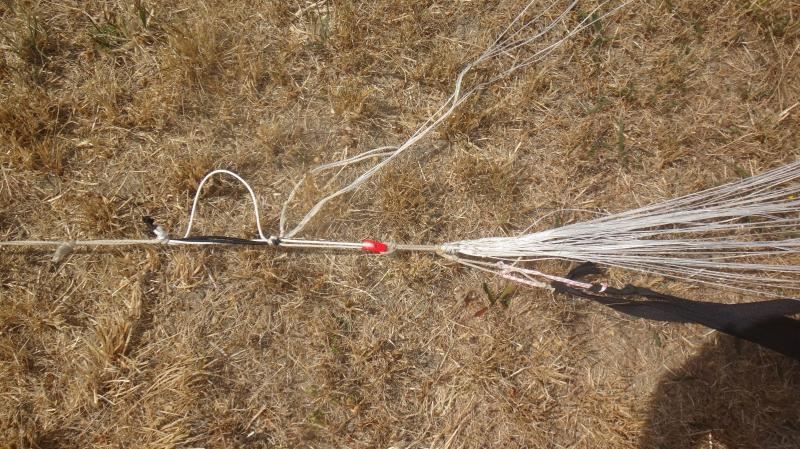
A later system (early 2020) separates out the leading edge and trailing edge bridles and attaches them together to a bungy from the main line attachment point, while leaving all the other bridles connected directly to the main line attachment point. This system retains the pulley system's anti-luffing characteristics by using the rear bridle tension as a proxy for total kite pull, while being much simpler (no pulley) and using lighter bungies. It works particularly well when the rear bridles are of the aeolian type because the tension in aeolian bridles increases at a faster rate than wind speed squared and increases as angle of attack decreases. It should be possible to set the bungy tension and extension limiters so that the aeolian bridles do not pull the rear of the kite downwards in strong wind- which is the main disadvantage of directly attached aeolian bridles. This system works well on Serpents but has not yet been tried on SSSL Rays.
Another and quite different approach to angle of attack control is 'flap' leading edges. In this system, the kite's bridles are not connected to the leading edge itself but at some distance back from the leading edge on the kite's upper surface. At high angles of attack and in light winds this flap is pushed out against the bridles by the pressure under the lower surface of the kite. In stronger winds and at lower angle of attack the flap is folded inwards, which has a similar effect to letting out the leading-edge bridles. This was first used on some of the very first SSSL Octopuses but was a failure- in retrospect because the flap was too wide and not adequately supported by the bridles it pushed against. In 2021, a much-reduced version- only on the centre front bridle pair and just 50mm wide- was tried on a 4 sq. m SSSL Ray- with apparent success or at least to no obvious detriment. This requires further testing and development.
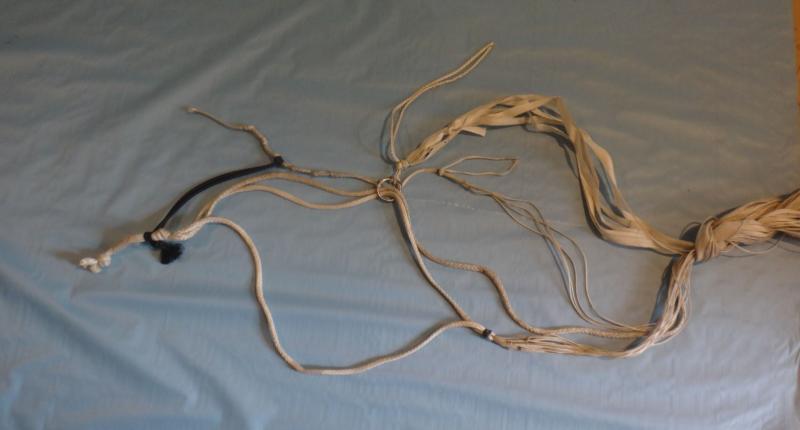
A possible approach (Feb 2021) that hasn't yet been tried, is to attach the bridles to the flying line via a catenary loop, with a bungy on its forward leg. This avoids the luffing problem that bungying just LE bridles has and would have the advantage that it won't only change the relative lengths of the front and rear bridles but spread the changes through intermediate bridles as well- somewhat similarly to the lever system.
SINGLE SKIN SINGLE LINE KITE DEVELOPMENT The first 10 years

I did get single skin single line kites (SSSL's) to fly almost from the start, but "fly" at first meant staying up briefly and only in a very narrow wind range. For many of the first 20 or so prototypes, the window between stalling (when the kite falls back, won't rise) and luffing collapse (when the kite's leading-edge buckles under and won't hold its shape) was vanishingly narrow. One reason for this was that I had based their leading edges on single skin traction kite practice- which is to have a lower leading edge, typically supported by partial ribs and projecting back as far as 10% of chord- as shown in the photo of SSSL10 above (leading-edge to the right), which has a lower leading edge of around 5% of chord. This type of leading edge is very angle of attack sensitive.
Another wrong assumption was that to keep the leading edge from buckling in, it was necessary to hook the kite's trailing edge downwards- also visible in the above photo. This can be thought of as 'capturing' enough pressure to keep the leading edge 'inflated'. Unfortunately, this also moves the kite's centre of lift rearward, which makes the kite much more likely to stall and reduces the weight moment available to point the kite upwards.
But even with these two constraints it was possible to make useable SSSL's. The SSSL 10 Sled style was developed further by adding a central rib and flown at various events in Asia and Europe during 2014.

Robert van Weers had also made at least one successful SSSL by this time, also incorporating a lower leading edge and hooked trailing edge.
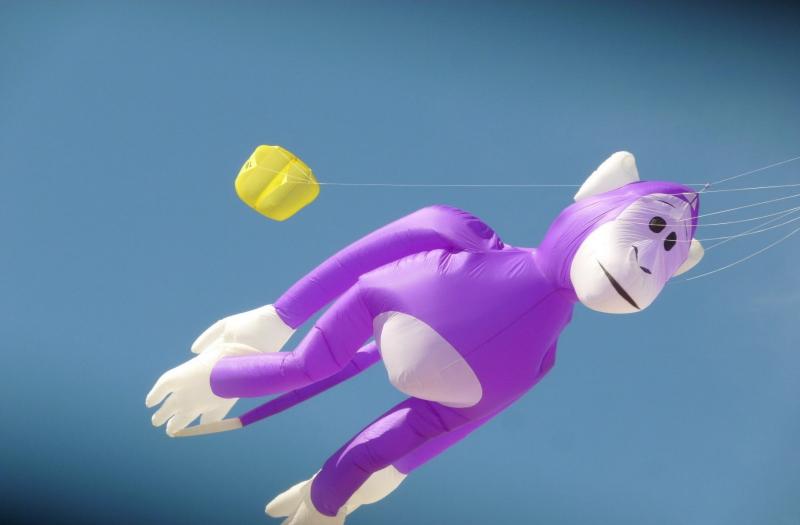
These early efforts had narrow wind ranges and even then, required multiple bridle settings. They were also subject to 'diving over'- suddenly diving to the ground from what had been stable flight with little or no warning, a phenomenon that was to plague my next 4 years of development.
Later in 2014 I began to work on eliminating the trailing edge hook-down that was the prime cause of the narrow wind range problem. That 'open' trailing edges are possible for single skin kites was by then known from single skin traction kites. A way they do this is to use more chordwise camber than the radius described by their bridles. Say the leading and trailing edge bridles are 3m long but the kite's skin is cambered to a 2.5m radius, then some (small) component of these bridle's tension will stretch the fabric out chordwise and counteract fabric compression. In practice, even bridles of the same length as the camber radius are effective at resisting skin compression. Reasons for this will be addressed later in Pocketing.
The 1Skin Saga; late 2014 to mid-2018.
Using the uniform camber principle (no trailing edge pull down), the 7 cell Boomer style SSSL was soon flying- followed by 5 cell 1Skins and 4 cell Singers.

While retaining the same leading-edge construction as earlier designs, the use of chordwise camber instead of trailing edge hook-down provided a much wider wind range. Their excellent lift to drag ratio gave them a 60degree plus flying angle and the usual pull/size advantage that single skin kites have over ram air designs gave a 3sq.m Boomer lift equivalent to a 10sq.m or larger ram air pilot. At this stage it seemed that intensive detail development would eliminate their remaining problems, which were:
*A tendency to lean over to one side or the other rather than flying straight.
* Requiring multiple bridle settings for different wind speeds.
*And sometimes diving over unpredictably when flying in winds above about 30km/hr.
I spent much of the next 3 years developing and refining the Boomer/1Skin/Singer style SSSL's, building close to 100 prototypes.
The leaning problem was addressed by reducing aspect ratio (AR). 5 cell ISkins are much less inclined to leaning over and 4cell Singers have the opposite problem- weaving instability, requiring a tail to quieten them down. The relationship between aspect ratio, leaning over, and weaving is explained in Single Line Kite Stability 2023 and is basically that increasing aspect ratio decreases weaving but increases leaning over.
The need for multiple bridle settings was largely solved by the development of automatic angle of attack adjusters.
This is covered in Automatic Angle of Attack Adjustment.
Diving over has proved to be a much more intractable problem.
The following are possible causes of 1Skin diving over that I considered (in no particular order):
Insufficient righting moment- that the centre of lift is too close to the centre of gravity to provide sufficient righting moment as the wind strength increases: SSSL's are very light. A 3 sq. m 1Skin weighs just 300gm- which is all the righting force that is then available when the kite leans over. In a decent breeze it will pull 40kg and more on the line. Additionally, SSSLs generally have their centres of lift at 35% chord or more (by comparison with sticked and ram air kites at 15% to 25%), which doesn't give the small weight force much leverage to pull the kite out of an arching dive.
That their centre of lift and centre of gravity are so close together is a consequence of the camber that SSSLs have to use in order to prevent compression buckling. That this does contribute to diving over is undoubted.
A first attempt to get the C of L further forward was to let off the rear bridles by 30mm or so, and this definitely helped, though it also allowed the trailing edge (TE) to buckle upwards in stronger winds (visible in the Boomer photo) which caused a lot of flapping and wrecked the fabric after a few hours flying.
The next approach was to reduce aspect ratio (AR)- a move from the 7 cell Boomer to the 5 cell 1Skin. Reducing AR has the effect of moving the C of L and C of G relatively further apart, giving the restoring moment of the kite's weight more leverage. Taking this further with the 4 cell Singer proved to be a step too far. Singers are weaving unstable without a tail. Singers still crash out in strong winds too, though at a higher average windspeed than 1Skins (which are better than Boomers).
The next attempt was to try kites with porous rear skins. The idea behind this is that leakage through the rear section would shift the centre of lift forward while keeping the C of G in the same place. A disadvantage was that the effect seemed to be greater in lighter winds- the opposite of what was optimal. At a small cost in light wind flying, they did seem to be a marginally better in strong winds, perhaps because of having more drag at the rear keeping the skin tight. Or it could have been the desired C of L shifting effect- or maybe I was just being hopeful.
A way to shift the centre of gravity rearward is to add a tail (see Tails in Single Line Kite Stability). Ribbon tails do improve the strong wind reliability of 1Skin type SSSLs. Their disadvantage is that they can catch on things (like children and adjacent kites) and make launching over water more difficult- which limits their usefulness for towed displays.
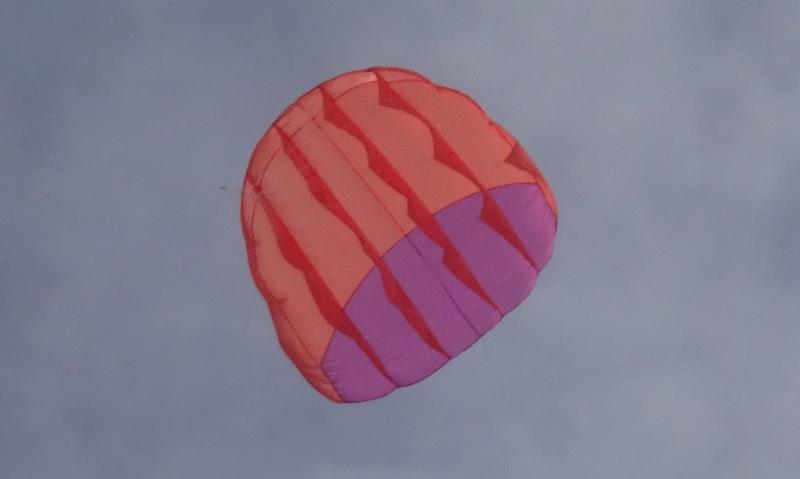
Bridle stretch. When a kite flies on any sort of a curve, its outer wing tip generates more lift than its inner tip by a square relationship. This creates more pull on the outer bridles and if they stretch significantly will cause the kite to dive over because of positive feedback.
I tried different weight polyester bridles (stretchy) and Dyneema bridles (not so stretchy) on various prototypes but couldn't be sure of what effect this was having. Diving over didn't decrease dramatically, even with hard finish (lowest stretch) Dyneema. There are also chordwise effects to consider. Because there is more tension on each flare bridle than on any leading-edge bridle, bridle elasticity could be expected to exacerbate any luffing tendency in strong winds, by pulling the leading edge down (relatively). I have seen the deleterious effects of stretchy bridles on larger ram air kites though not yet unequivocally on 1Skins - but still tend to use Dyneema bridles, just in case there is something disadvantageous going on.
Asymmetric fabric stretch. Kite fabric when heavily loaded, as it is by SSSL's in strong wind, often does not stretch symmetrically because fabric's warp threads don't have the same spacing as the fill threads and are often not at right angles to each other.
Every 1Skin I have made flew differently and required some tuning for straightness, even after bridles had been re-set to exact lengths after a settling in period. This can only be because of tiny sewing and fabric asymmetries. These could be contributing to diving over, but my sense is that other things are causing the diving over while the kite's basic asymmetries just decide which side the kite is eventually going to dive off to. Even perfectly tuned 1Skins can still misbehave in strong winds.
Migration of the centre of lift. This is a speculation that as a 1Skin'ss angle of attack approaches zero (high flying angle), flow attaches progressively to the upper surface, rather than separating in a turbulent wake. If this causes the kite's centre of lift to shift back behind the kite's centre of gravity it would cause diving over.
To test this theory, I tried flow separators at around 1/3rd chord on the upper surface. There was no noticeable improvement.
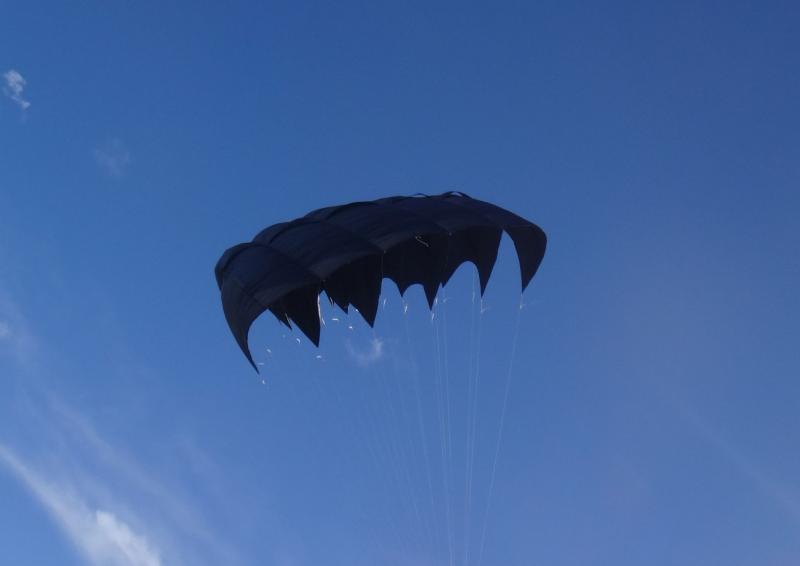
Chordwise buckling. When flying, 1Skins often show spanwise crease lines (see Boomer photo). These are sites where further buckling is likely to occur under compressive loads. If these develop at all asymmetrically then they can, and eventually will cause diving over.
As explained earlier, provided a kite's camber is of lesser radius than the bridle lengths, some small component of bridle tension is available to keep the skin unwrinkled- in which condition it's best able to resist compressive (buckling) loads. But as using more camber causes the centre of lift to move too far towards the rear, there's a fine balance to be struck. Another way to reduce chordwise buckling is to apply some chordwise tension to the fabric by adding drag at the rear of the kite- like by adding a tail or tails. Doing this by hooking the trailing edge has been ruled out but hooking the trailing edges of the outer flares could accomplish the same thing (and is used on later SSPs). However, 1Skins that have substantial tails still sometimes crash out in strong winds. So, though asymmetric chordwise buckling is definitely a cause of 1Skin diving over, it's not the only cause.
Fabric creases. For strong wind flying, 1Skins generally require re-tuning for straight flying after being packed away. This seems likely to be because the creases from tight packing are in different places each time and have an initiating effect on where compressive buckling occurs when flying.
Softer (non-creasing) fabric would be an answer, but such fabrics stretch more and are less dimensionally stable, so would cause other problems. Basically, that this is a cause of 1Skin asymmetric flying, tells me that the design is too sensitive. Successful kite designs need to have a margin of reliability sufficient to cope with aging, minor damage and small left/right differences.
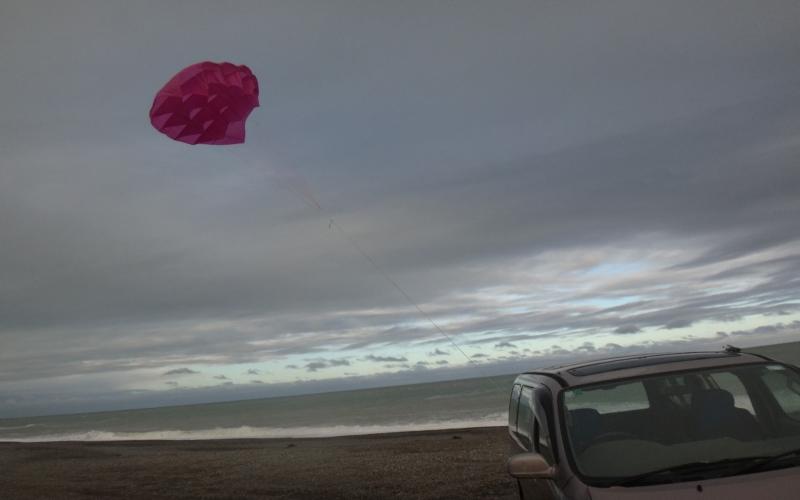
Leading edge buckling (indenting) in stronger winds and at lower angles of attack. This is a certain cause of diving over; SSSL Octopus, Serpent and Ray kites all dive over if their LE's buckle in. But these designs have bridle supported LEs that are automatically let out as A of A decreases (higher flying angle) and can have their LE's let out enough to stop buckling without stalling. Boomers, 1Skins and Singers do not have bridle supported LEs- their forward bridles go to flares that are back from the actual LE (see 1Skin photos). They also have little margin for letting out their LE's further to prevent LE buckling because of their more rearward centre of lift (a function of chordwise camber used to prevent chordwise buckling)
As a possible solution to LE buckling, I tried fitting double skin leading edges to 1Skins, with the space between ram-air inflated (I know, I know, cheating again- and I tried the same check on an Octopus and Serpents too). The results were equivocal; definitely more reliable, but not a complete cure- for this to be a complete cure it's likely that this ram air space would need to be a significant fraction of the chordwise dimension- a hybrid ram air/single skin design - which works (I've built hybrid Serpents which fly well) but this is not what I'm trying to do here.
Simon Freidin (Melbourne) tried another idea to reduce leading edge buckling: Air dams. These are fabric dams across the kite's cells positioned so as to 'bounce' some pressure back to the kite's leading edge, in order to keep it 'inflated'. They do seem to do what they are supposed to do to an extent. But 1Skins fitted with air dams still sometimes dive over when flying in strong winds, and at least some of the improvement seen with Simon's kites is likely to have been because fabric stiffness was a greater factor because of their small size. .

Asymmetric leading-edge buckling is a primary cause of 1Skin diving over, and nothing tried so far is a sufficient cure. Occasional satisfactory strong wind flying is almost certainly because on these occasions, leading edge buckling just happened to be symmetrical enough not to make problems.
My Verdict on ISkin style SSSLs:
When the wind becomes strong, the 1Skin style of kite will sometimes dive off to one side or the other. The primary cause of this is leading edge buckling. Leading edge buckling occurs because their LE's are not supported by bridles incorporating automatic angle of attack adjustment and because the leading edges cannot be let out enough to prevent buckling without causing stalling. That there is little margin for letting out the leading edge is because they need significant chordwise camber to prevent chordwise buckling in stronger winds. This shifts their centre of lift back uncomfortably close to their centre of gravity (see First Law). Later SSSL designs use other ways to prevent chordwise compressive buckling (see Pocketing).
Although sometimes flying outstandingly well, especially in light steady winds when their high lift for size is useful for lifting line objects, Boomers, 1Skins and Singers remain generally unsuitable for use as pilot kites at busy kite events because of diving over crashes.
Pretty much a failure therefore, but without what I learnt from I Skin development (3 years and more than 100 prototypes), later successful designs (like the Rays ) would not have happened.
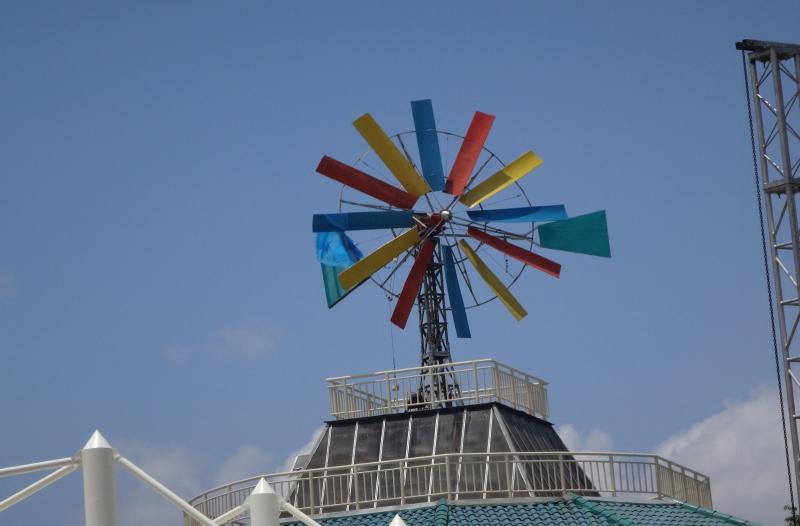
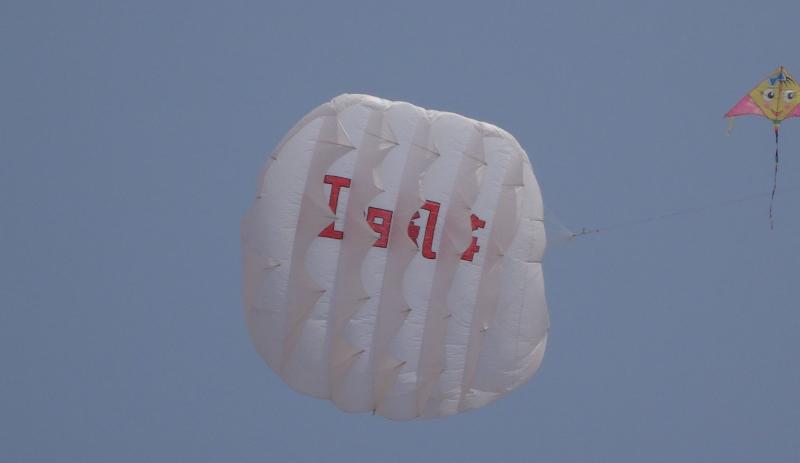
.
SSSL Caterpillar
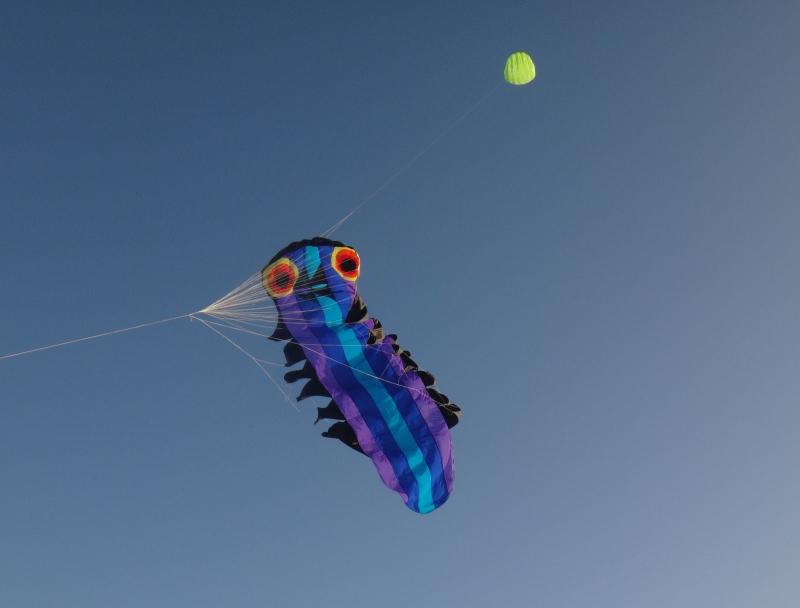
I had thoughts that the head would be the kite and that the body would function as a tail for flying alone. In practice, the bridles to the legs made the body buckle up rather than stream out flat. It's therefore just another wannabe kite that became a line object, having lift but no stability and requiring a pilot kite to keep it pointed up (a 1Skin in this picture).
SSSL Octopuses
Early in 2015 I tried an SSSL Octopus, a kite type style that I've had a long association with, from small, framed octopuses, the foundation of our business in the late 1970's, through to large ram air versions from 1990. It immediately flew well.

After a few more prototypes and a lot of fiddling with bridles, these SSSL Octopuses began to show the ability to recover from the asymmetric leading-edge collapses which are generally terminal for 1Skins. When the wind is too strong for a particular leading-edge bridle setting on these Octopuses, one side of the head collapses a little, then the opposite side and so on. These brief collapses, which happen on the right-hand side when the kite is tending right and on the left when it is diving left, cause the kite to immediately correct back to central flying. Of course, if the wind then becomes too strong for wherever the front bridles are set at, the kite's leading edge will eventually collapse, taking the kite down- but this can be addressed by fitting an automatic bridle adjuster. The self-correcting response occurs because the highest apparent wind flow strikes the side that the kite is veering off to - which causes the head's leading edge to buckle in (indent) on that side. This buckling slows the kite's sideways movement but does not in itself correct the lean that has by then developed or send the kite back to the centre. Correction occurs because wind flow is not now parallel to the centre line of the kite but slightly transverse, favouring the side that isn't indented. This generates lift that sends the kite back towards the centre. Essential to this mechanism is that there are no keels or flares in the centre area of the kite to prevent the action of this transverse flow. As I've gradually learnt how this works and how to design for it, collapse resilience has become a key feature of later SSSL's.
SSSL Octopuses (and their Serpent siblings) have a lot of bridles- up to 60, but all of these except the ones around the leading edge and across the rear of the head are the same length, which simplifies bridling a lot. Given the "bridle lengths should be no shorter than the camber radius" theory described earlier, this is no great surprise, but it is surprising that it is so optimal- and believe me, I have tried many minor variations. That the bridles don't need to be longer than the camber radius to stop chordwise (and spanwise) buckling can be explained by the beneficial effects of pocketing, which is described later.
Unfortunately, single skin octopus tentacles tangle. After flying in mid to strong winds, sometimes they take hours to untangle. Many anti-tangling ideas have been tried: Various tapers, pointed ends, flat ends, stiff fabric, soft fabric, silicon coating. The tentacles of small, framed octopus kites don't usually have a tangling problem, so I presume that it's a function of size and relative fabric stiffness. Nothing (so far) works for the SSSL 20m Octopuses except linking the tentacles together with cross cords (as in the photo above)- leaving just enough free sideways movement so that they don't function as one wide tail (see later discussion about tail width effects on stability). This reduces tangling by a lot - but isn't a complete fix.
Doubly unfortunately, linked tails are a menace- they catch on every available obstruction, especially during launching, which can be dangerous. This has made SSSL Octopuses impractical for general festival flying except in very controlled conditions.
Apart from this, with the addition of pulley and bungy automatic angle of attack adjusters, sometimes incorporating aeolian bridles, they have developed into what is still one of the better all-round SSSLs I have yet made. With the side head bridles shortened a little to provide some extra lateral area, the 20m size can attain a wind range from less than 10km/hr to more than 70km/hr with stable flying even in gusty conditions.
SSSL Serpents
To get around the Octopus tentacle tangling problem, from June 2015 I tried using the Octopus style head with a single tail - Serpents.
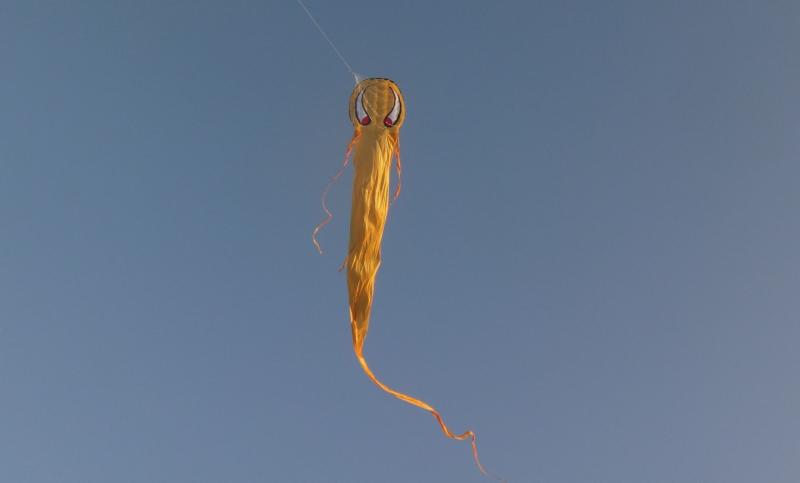
An immediate problem was that they became weaving unstable from about 20km/hr. I then spent years working on lifting their wind range, trying variations in bridling, but also different tails- MANY different tails. None of which worked, because I was mistaken in thinking that the early onset weaving instability was because of insufficient tail drag. It wasn't. In a quick and dirty test, a knot tied in the tail just below the head was found to substantially reduce weaving instability- showing that allowing the head to rotate independently to some extent was an answer. Serpent style tails are attached full width and taper from there to the tip. This doesn't allow the head to correct from a lean except by pulling the entire tail around with it. I'm not exactly sure why, but in some way, this causes weaving instability in stronger winds. Many attempts at rigging Serpent tails to heads in ways to allow some independent movement failed. And yes, some used bungies and I tried leaving a gap. I also tried slitting the tails in the section nearest the head to mimic Octopus tentacle attachment, but this caused leaning over because they generated too much drag at the slit ends, unless the slits were extended full length- when they tangled of course. Many of these attempts weren't graphically acceptable anyway.

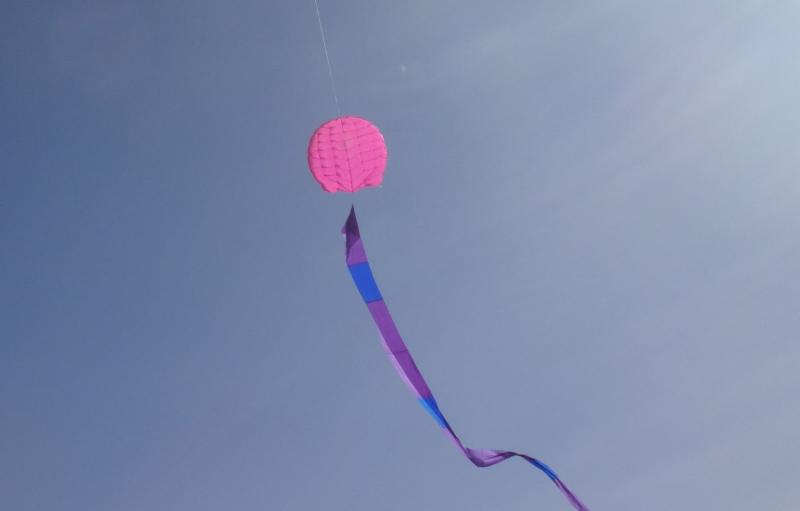
Eventually I made two 2m wide Serpent heads and compared them with tails attached in different ways. This quickly showed that a Serpent head will fly in light winds without any tail at all, though they're inclined to lean over because their centre of lift (where an extrapolation of the flying line intersects with the kite) is a bit too close to their centre of gravity. Adding a tail mitigates this, moving the kites centre of gravity rearward and adds some useful drag.
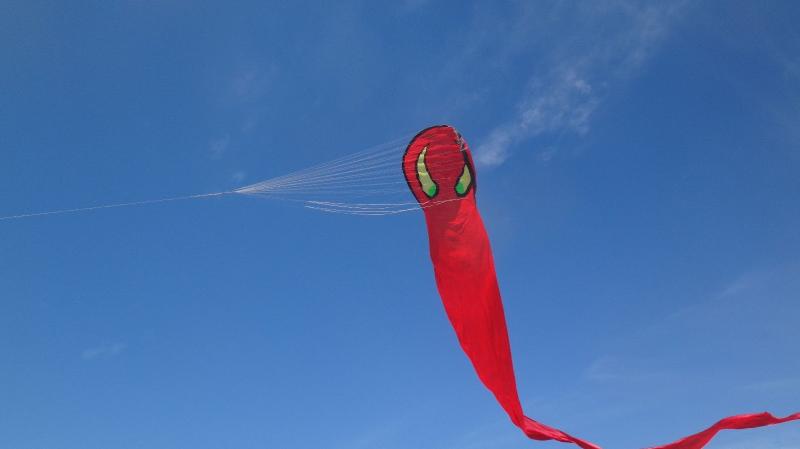
This didn't solve the Serpent problem of course because a serpent head with a ribbon tail isn't a relatable kite, but at least it advanced my understanding of weaving instability, its causes and remedies.
And then Serpents served up another curve ball.
Before making the 2/3rds size Serpent heads (half the area of the 30m), I'd made a double sized SSSL Serpent (4 times the area of the 30m, so 4 times the pull). I'm not sure why I did this because there was every reason to expect that its upper wind limit would be the same as for smaller Serpents, around 30km/hr, which makes them unsuitable for kite event flying.
This scaled up Serpent (bridling and panels scaled exactly and weight/area the same) is stable in any wind speed I've yet had the courage to fly it in- > 60km/hr. Only at this maximum have I seen even the slightest beginnings of weaving instability. For a while I thought this was because of the way the tail had been intentionally cut to take tension down its centre rather than along the edges, (allowing the head some rotational independence) but this was thoroughly de-bunked by the next 60m Serpent built.
Is entrained air mass the culprit? Boundary layers grow with chord- the greater the distance there is between the leading and trailing edge the thicker the boundary layer will be, and this boundary layer and wing tip vortices are to a significant extent 'attached' to the kite- which has to drag them around when correcting. These air masses scale with the cube of dimension not the square, so theoretically could be an explanation for stability changes with size.
In 2022 I found that SSSL Rays were also much more resistant to weaving instability in larger sizes. That ram air inflated kites generally do scale (ram air flag kites by more than 3000 times for example) is a challenge for this theory though- unless the SSSL's very much higher lift coefficients (pull for size) is also a factor.
The striking differences in behaviour between 20m SSL Octopuses, 30m SSSL Serpents (which have the same head and bridles), 70% sized Serpent heads with ribbon tails and 60m Serpents (also with scaled bridling) has been instructive and eventually led to a key understanding of weaving instability which is that weaving is a function of the angle that a kite leans to when it is returning to alignment with the wind direction (after a wind shift for example). A kite that always points up never becomes weaving unstable.
Apart from being a learning experience, the only Serpents which have satisfactory all-winds performance so far are the 60m versions, and this comes at the cost of ferocious pull- perhaps as much as 400kg in the upper limit. To mitigate this I've fitted them with take down system, that after some refinement, collapses the kite completely and immediately with just a few kgs pull on the take-down line. .
An incident at Berck sur Mer France in 2019, when one launched unexpectedly and could have resulted in fatalities, was a strong reminder to be wary of large SSSLs, even when fitted with take-down lines. Another in Kuwait 2023 , when an anchor rope broke, provided a strong reminder.

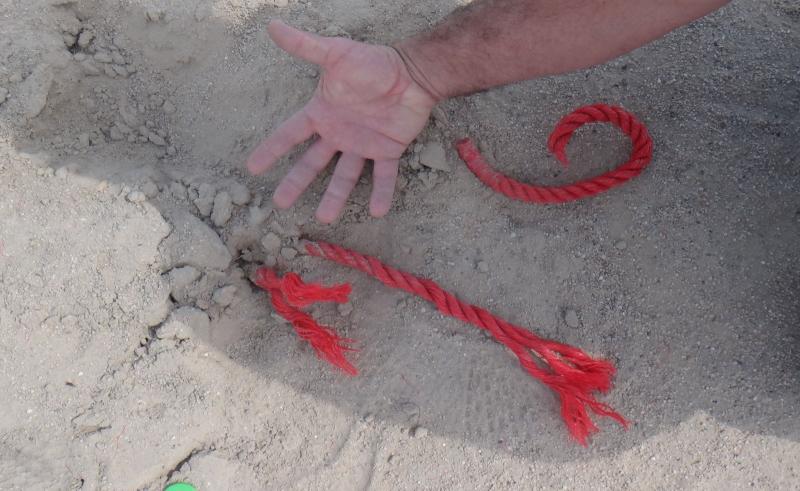
Lots of pull aside (an advantage when they are used as mega kite pilots), 60m SSSL Serpents have only one significant fault: Falling Off- a tendency to stall off to one side when falling back if the wind drops a lot. Automatic angle of attack control has reduced this tendency, but it is a fundamental characteristic of the tail attachment to the head, so may not be able to be improved much more.
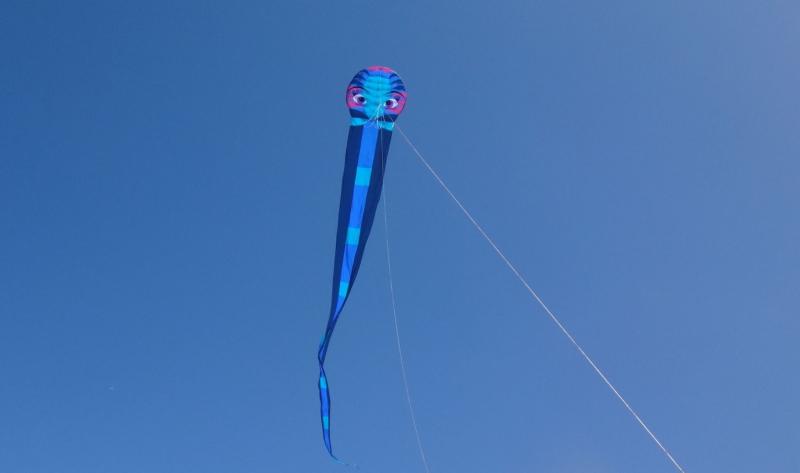
. Sleds

The first SSSLs I tried were sleds, mainly because they are simple and don't require lots of bridles. The early versions used trailing edge hook-down to prevent skin and leading-edge collapse, and had lower leading edges supported by partial ribs.
The Arc Sled (below) is the simplest SSSL I can envisage and could be refined to require just a two- leg bridle. Unfortunately, this one had very slow recovery, showing almost no inclination to fly at all. Later understanding suggests that the amount and disposition of its lateral areas are likely to have contributed to this. Even back then I must have had some suspicion of this, judging by the holes I cut in the keels. The large trailing edge hook would also have contributed to diving over by reducing the magnitude of the available righting moment.
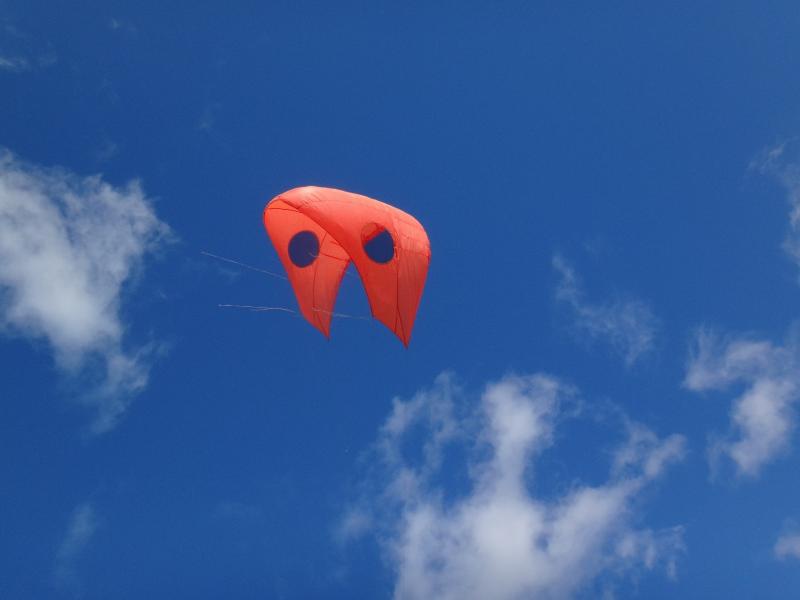
I have occasionally tried other sleds, later ones all using ways to reduce chordwise compression and leading- edge collapse other than by trailing edge hook. They have additional leading-edge bridles, so are not strictly sleds, but it may be possible to eliminate these bridles when everything else is optimised, so I've continued to call them sleds.
In early 2020, after becoming aware of the advantages of pocketing (see Single Skin Pilot (SSP) section), they were refined further. Although they will fly in very light winds and have good collapse resilience (the ability to self- correct from partial shoulder collapses) they are bad leaners and do not yet fly in strong winds.
With aspect ratios of around 0.5 this is unlikely to be because their righting moment is too small and is likely to be because they have too much rearward lateral area. SSPs (single skin pilots) have less rear lateral area and don't usually lean much. There is limited scope to reduce the rear lateral area of sleds because it's used to hold the trailing edge open in the absence of trailing edge hook. They will certainly need automatic angle of attack control to achieve a useful upper wind range.
Fixable? Or are SSSL sleds another lost cause?
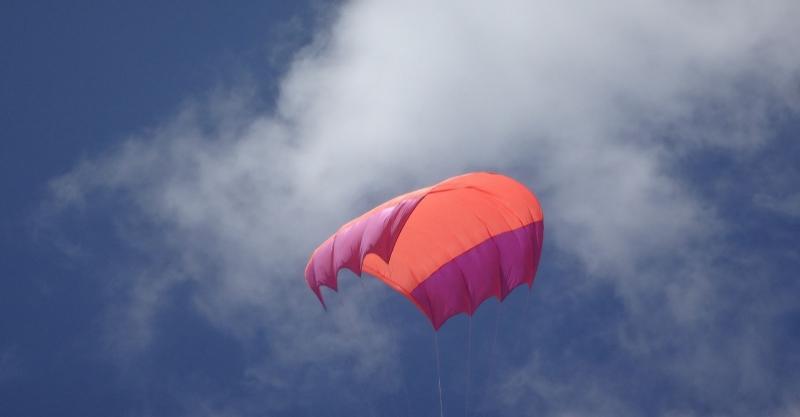
Single skin pilot kites (SSPs)
This series started when I finally accepted that 1Skin style SSSLs were fatally flawed and from the realisation that Serpent heads fly very well with ribbon tails- and with no tails at all in light winds.
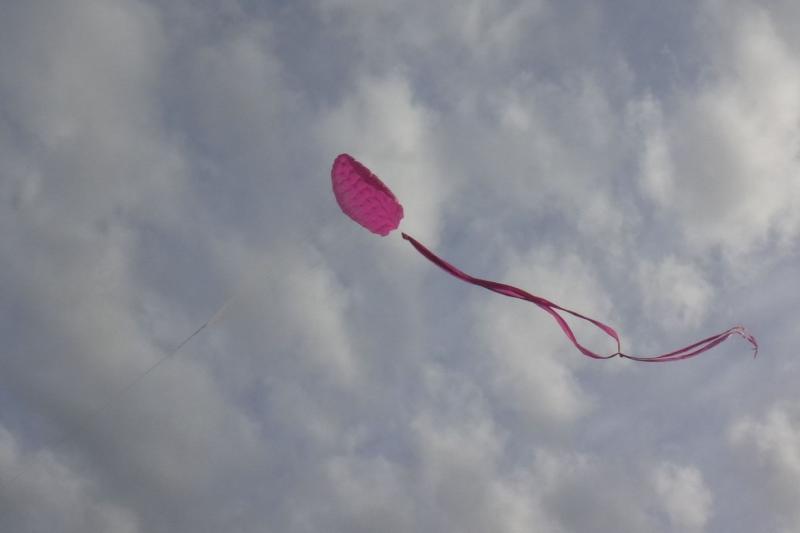
Initially I'd made a Serpent head with flares instead of a tail (January 2019), but it wouldn't fly at all, seeming to have little idea as to where 'up' was and absolutely no inclination to go there. Fortunately, I'd had problems with lateral area disposed too far rearward previously, so cut the flares off and tried again. It then flew exceptionally well with a small tail and automatic bridle: Wind range from less than 10km/hr to more than 60km/hr, high flying angle, lots of pull, minimal leaning, and no diving over.
But 62 bridles seemed a bit daunting for other than one-off making, so I then started on a bridle elimination mission. The first attempt was to graft a Serpent leading edge onto a 1Skin (by the assumption that the key difference was the Serpent head's bridle-supported leading edge).
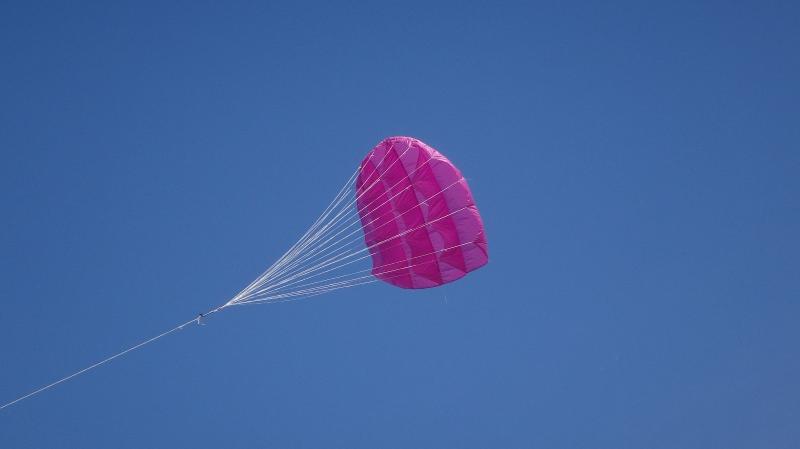
Its leading edge did not seem to be much better than the rib supported system, and then I belatedly re-remembered the theory that Octopus and Serpent head self-correcting responses to leading edge collapse requires the centre head area to be free of ribs and flares. I'm reasonably confident of this explanation- but not completely certain without more testing.
I then tried several semi-circular leading-edge open centre SSSLs with reduced bridles. but couldn't get 100% satisfactory flying - though they were more reliable than many of the 1Skins, so some progress.

To reduce weaving instability, and to reduce the number of bridles required down each side, the size of the flares was then increased. This made a problem of what to do with the extra keel depth around the curved head, so the leading edge was squared off.
At which time they also acquired a name: SSPs - Single Skin Pilots.
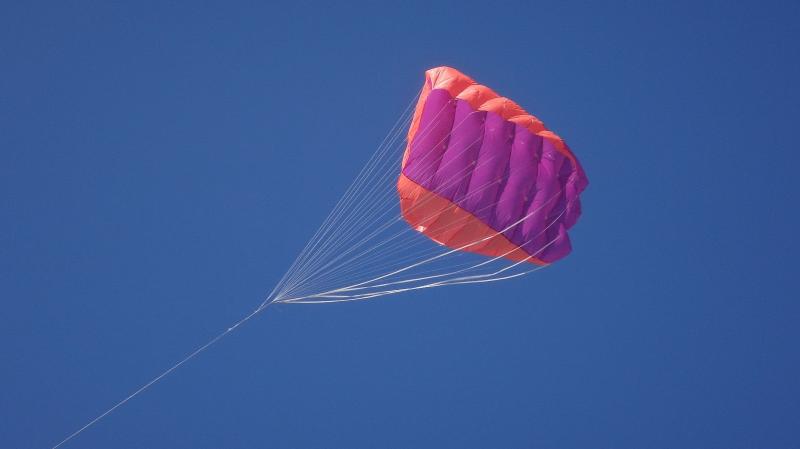

By January 2021, SSP's were flying in quite strong winds with no diving over, but reliable strong wind flying while also retaining good light wind performance remained a challenge.
SSP 5 has slightly higher aspect ratio - to reduce weaving- and 22 bridles only. It also has the flares curving round the trailing edge slightly which has reduced leading edge collapsing markedly. The added drag from these lateral TE hooks helps keep the leading edge from collapsing, reduces chordwise buckling, and does so without the downside of shifting the C of L rearward, as was a problem with pre-Boomer TE hook. The drag from these corners is equivalent to the drag from tails, but as they have very little weight, they don't shift the centre of gravity rearward as tails do. for all that, their addition has improved tailless flying.
For some reason I don't yet understand, these SSPs require less bridle adjustment than Serpent head SSSLs- just one for most conditions, another for very light winds and a third for strong winds (2m Serpent heads require 3 plus an auto bridle). For this reason, SSP's haven't yet had auto bridles fitted. Maybe the catenary auto bridle system described under Automatic Bridles will be useful for these kites.
They also have the self-correcting response to leading edge collapse first developed in Octopus SSSLs that makes SSSL kites much more reliable in gusty winds.
Keel leading edges are critical- if they flare outwards, the kite tends to hang to left or right, rather than in the middle, but if they 'toe in' too much, the shoulders collapse in stronger winds. Currently I'm not sure there's any fabric cut that will not be subject to one or the other.
Will they get to be good enough for general use as pilot kites? Too soon to tell.
Pocketing
Another development has been the use of "pocketing"- or rather, the recognition of its function and its deliberate exploitation.
For a long time I regarded bumps and hollows in SSSLs as imperfections and strived to minimise them as far as possible by adding more bridles and using careful fabric orienation where appropriate to take advantage of bias stretch (where practical, bridles should be connected to cords sewn diagonally to fabric so as to spread loads, avoid stress points and reduce creasing). I then had ocassion to make two identical Serpents, and was puzzled when one of them required an extra row of bridles to prevent chordwise compression. The difference was in the fabric- one was made of soft-finish fabric, the other hard. Looking at these kites it could be seen that the softer fabric was pocketing noticeably more between the bridles- and this was on the kite that needed less bridles. This kite also flew in stronger wind before weaving instability onset.
About then I started to use the grid pattern of reinforcing and bridle attachment cording to increase this pocketing.- by setting the thread tension higher while sewing on cords. Extra drag from these deeper pockets replaces drag that would otherwise have to be added elsewhere - like from tails, tapering lateral area or bridling to increase the angle of attack.
But it wasn't until the SSP series that I realised that this pocketing was also improving overall compression resistance (spamwise and chordwise). For SSSLs like the 1Skins and some Sleds, which are quite smooth, compression creases become more evident as wind increases. These creases rarely develop symmetrically and are a cause of strong wind instabilty by causing one side or the other to eventualy compress, diving the kite to that side. For Octopuses and Serpents with discrete pockets defined by bridle spacing, very little chordwise or spanwise ompression is visible in any wind speed I've flown them in yet. For SSPs, some distortion is visble near the trailing edges in strong winds but this doesn't seem to be destructive of stability.
For rectangular bridle cells, I can see why the central part of each pocket resists spanwise and chordwise compression forces better than flat surfaces. I don't clearly understand why they also resist compression better at the 'fold points' on their boundaries- but they do seem to.

For diamaond shaped bridle cells as used for SSSL Rays, the overlapping arrangement clearly adds spanwise and chordwise compressive rigidity.
SSSL Rays


Early in 2015 I started to try a few single skin ideas for themed kites. The first SSSL Ray had a bad case of diving over, would barely stay in the sky long enough for a photograph- even with a heavy rope tail. By 2020, I did get Ray style SSSLs to fly relatively satisfactorily in mid-range winds, but only at the cost of reducing aspect ratio to the point that they look more like Indian fighter kites than Rays. (see Aspect Ratio in Single Line Kite Stability for an explanation of this effect).
.Ray 4, February 2020 with a tapered tail flew reasonably well but suffered from weaving in quite light wind, as did Ray 5 above. Later in 2020, in order to get some lateral area to address this I re-bridled them with anhedral (wings sloping down, the reverse of dihedral). Their bridles had previously all been the same length except for the leading edge. This was a miraculous fix with a remarkable improvement in stability and no apparent down-side. It increased the onset of instability from around 25km/hr to well over 40. Very quickly after this I built an 8 sq. m version which was stable through to even stronger winds (because larger SSSL kites are inherently less inclined to weaving instability for reasons I don't yet properly understand). This first 8 sq. m SSSL Ray also had another improvement, its rhombic panels being cut with convex rather than straight sides to create more 'pocketing' for better chordwise stiffness- see explanation under Pocketing.
To improve the stability of the 4 sq. m size further I then built one with higher aspect ratio- this being one of the strongest determinants of weaving stability for kites. Lifting aspect ratio from 1.21 to 1.31 did the trick for this size and seems to have had about the same effect as scaling to 16 sq. m has (this 4sq.m and a green 16 sq. m built in February 2023 (aspect ratio 1.21) appear to be very similar in strong wind stability, both being a little better than a blue 1.21 aspect ratio 8sq.m built in late 2022.
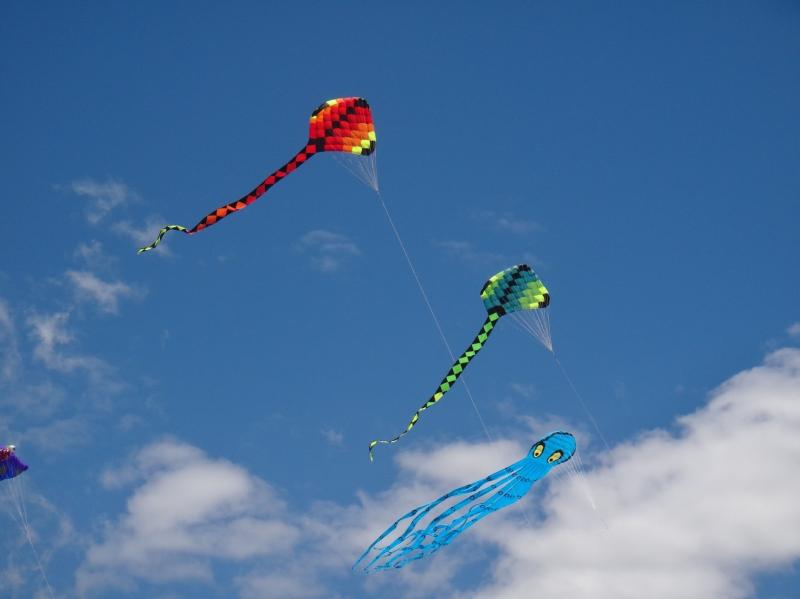
By January 2022 even these early SSSL Rays had become the best flying single skin kites I've yet developed- better than 1Skins because they do not generally suffer from the 1Skin's idiosyncratic "diving over" in strong winds (or at least not until the wind speed is such that sane people have pulled down). They are also superior to the Octopus in not being plagued by tail tangling while being stable in strong winds, even in the 4sq.m size for higher aspect ratio versions. And they are ahead of the Serpents, which are only usable in stronger winds in the 60m size (because of scaling effects) which have more pull than most people are comfortable with (including me at times).
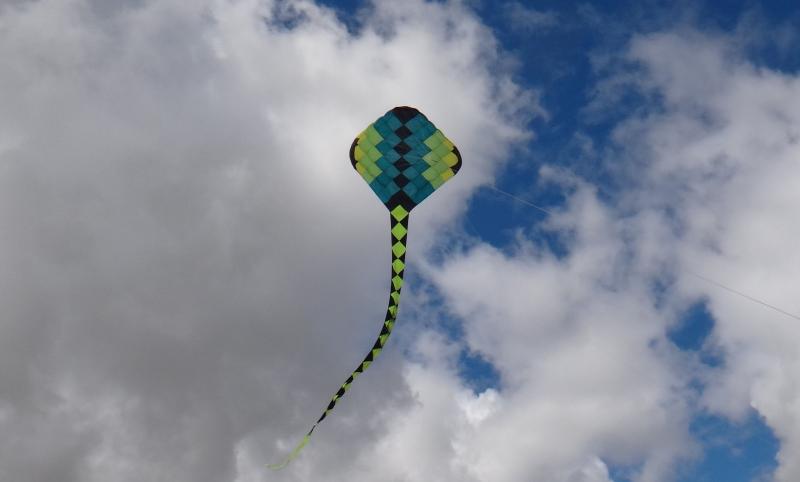
But now the adage "when you're 90% there, only 10% of the job is done" comes into play. Sure, after 10 years it is a relief to finally have SS kites that can sometimes be flown at events without requiring too much indulgence from adjacent fliers. But standards have changed. In the 1990's these early Rays would have been at least averagely reliable, but by the 2020's kites flown at festivals have improved a lot. Contemporary pilot kite/show kite train systems generally now stay out of trouble in a wide range of winds even at difficult flying sites (festivals often prioritise locations close to major population centres).
These Rays do have multiple stand-out features (in addition to the single skin novelty of having no structural elements); high flying angle, lots of lift/size, easy launching (sometimes too easy- with self-launching in strong winds being something to watch out for), light weight and small packed size for airline travel, and more attractive shape and graphics than conventional pilot kites. Another feature is take-down lines for the larger sizes. A 16sq.m SS Ray pulling 200 or more Kgs in a strongish wind can be instantly de-powered and will drop to the ground with just 5 kgs pull on the take down line (generally 2.5mm). Although they can be fitted, I generally don't use a take-down line with the smallest size (4sq.m) because these don't have much more pull than, say, a 12 sq. m parafoil style pilot kite- which are routinely pulled down the hard way. To be fully accepted, though, these Rays need to be even more reliable,
In very light winds, like all single skin single line kites I have made to date, they have a tendency to fall off to one side or the other when the wind is insufficient to keep them flying. At crowded events this drapes their line across every adjacent kite, which is not very neighbourly. Falling off appears to be a function of their stall characteristics (one wing always stalls first, causing the opposite wing to pull the kite off to the stalled wing's side). This could be addressed by the development of an automatic bridle adjustment system that reduces their stall speed to 7 or 8 km/hr- a low wind threshold which is possible now with manual bridle adjustment, but at the cost of losing from 15km/hr up. There was some progress in this during 2023, but not quite to equivalence with ultra-light ram air rays and pilots, which they will need to match if they are to be a truly "all winds " kite. I think this is achievable but for now, their high wind deficiencies are more pressing.
The largest single skin Ray (16sq.m) is rock stable thru to any wind that it's practical to fly in, but as of June 2023 smaller versions were more nervous making as wind speed increased, showing tendencies to move around too much- sometimes classic weaving instability and sometimes slow recovery- heading off to one side or other a long way before coming back. As has been observed with other single skin designs, there is an as yet poorly understood scale effect which causes larger versions to be progressively more stable as wind speed increases. This is of particular concern because it's only smaller sizes (say 5sq.m and less ) that will be practical for most kite fliers because of their high pull/size.
During 2023 a goal was therefore to improve the strong wind reliability of the high aspect ratio 4sq.m size (which already has an inherent advantage relative to lower aspect ratio versions as explained earlier).
In this program there were three kites (all 4sq.m high aspect ratio single skin Rays): Green, March 2022, Purple, January 2023 and Blue November 2023. Green flew well with a reasonable lower end (10- 12km/hr and reliable to above 40km/hr. Purple, made from the same patterns and with the same bridle dimensions was persistently weaving unstable at lower windspeeds than Green even after multiple changes, as was Blue. Changes were made to Green only after repeated testing against Purple and Blue.
In December 2023, an 80mm increase in anhedral enabled Purple to fly in very strong winds (above 60km/hr), better than Green, and this change worked similarly for Blue (leaving Green as a reference).
They both still sashayed unacceptably in high mid-range winds, more repeated traverses rather than classic weaving.
To identify the cause of this, in early January, Purple was reconfigured to Green's exact panel dimensions (the LE had been 50mm tighter and the wing tip panel was 25mm narrower). These changes did not appear to make any difference.
Purple was then re-bridled to Green offsets, copying all its various minor variations (up to 30mm).
Purple then flew very similarly to Green (upper mid-range, hard work to pull down).
An observable difference was the elimination of transverse creases in the centre front area.
Removing Purple's remaining two pair of TE bridles did not hurt stability (maybe a slight improvement?).
Letting off two more pair of second row rear bridles by 30mm or so also appeared to be an improvement.
During this time, the leading-edge flaps on Purple and Blue were also changed to the configuration used on Green.
Overall, bridle's reduced from Greens initial 74 to 60.
This design is now ready for general release- though refinement will continue. In lighter winds weaving is desirable, providing a useful reduction in the minimum wind speed required, but this is difficult to accomplish without compromising stability in stronger winds. A further reduction in minimum flying speed via the auto bridle or some other changes will be sought. In very strong wind, for safe flying, kites should eventually succumb by leaning rather than weaving. If the upper limit is still insufficient, more anhedral will be tried.
Onwards and Upwards
While continuing to improve SSSL Ray performance, there are a few other designs that may be worth pursuing- SSSL flag kites for example (I've had one sort of flying) and the continuing quest for single skin pilots of course.
Peter Lynn, Ashburton New Zealand, January 1, 2024